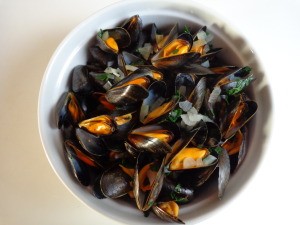Mussels steamed in white wine
This dish is an absolute breeze to make. It takes five minutes from beginning to end — providing you’ve got a cook’s helper to beard the mussels for you. If not, add on another 10 minutes. The ‘beard’ is what the mussel uses to attach itself to its bed. It looks like a tuft of hairy algae along the rounded edge of the mussel. To remove it, grasp it firmly and give it a sharp tug.
I prefer to use smaller mussels for this dish, as I find they are sweeter and more tender. If they are not available where you live, larger mussels will also be fine. The key is that they should be very fresh — if possible, straight from the sea. When you get them home from the market or fishmonger, place them in an uncovered dish in the fridge until you are ready to prepare them. This will allow them to breathe and stay fresh.
How to eat the mussels? In France, the tradition is to use an empty shell as a pincher: Take a mussel, shell and all, with the thumb and finger of one hand, and pinch out the tender morsel using the empty shell in your other hand. No utensils necessary, but be sure to give everyone at the table a soup spoon for the tasty broth at the bottom of the bowl.
Tip: Do not use salt with this recipe. The seawater inside the mussels contains plenty of salt, and more would be too much of a good thing.
1 quart (1 liter) mussels, preferably small
2 tbsp. finely chopped parsley
1 medium onion
1 tbsp. butter
1/2 cup dry white wine
freshly ground black pepper
Place the mussels in a colander and rinse with cold water. Now transfer them to a bowl full of cold water and, one by one, remove the beard, rinse and place back in the colander. If any mussels are open and do not close back up when you place them in the cold water, discard them.
Finely mince the onion. Rinse and chop the parsley.
In a large, deep, heavy-bottomed pot, heat the butter to sizzling. Add the onion and sauté briefly, about one minute, until wilted. Add the mussels and stir. Add the wine. Grind in some black pepper. Turn up the heat and cover the pot.
Check the mussels after a couple of minutes to see whether they have all opened. If not, give them a stir and cover the pot. Check again after one minute more. Your aim is to remove the mussels from the heat as soon as they have all opened to ensure they stay tender and don’t get rubbery due to overcooking.
When the mussels have opened, remove from heat. (If there are a couple that did not open, discard them as they may not be good.)
Add the parsley and stir. Ladle into shallow bowls and serve immediately. Serves 2.
What to serve with the mussels? Crusty bread, a chilled dry white wine, with perhaps a salad to follow. And be sure to place a large bowl on the table as a recipient for the empty shells.






Sounds lovely – I always add some double cream after removing the mussels as I think it gives the dish more flavour / depth.
Hi Derek. Moules à la crème is delicious! But it’s a slightly different dish. In France we make it by adding a little cream — generally crème fraîche — once the mussels have opened, but while they’re still in the pot. Happy eating!
Thank you so much for this! I feel somewhat stupid to find out that it is not that complicated to make mussels, which my husband and I have always thought of as a dish we would only have in a restaurant. Now, if I can only be sure to find a supplier here in L.A. whom I can trust to have super fresh mussels….
BTW, really great photo this time too! Nice and sharp with gorgeous color. Did you get a new camera? I noticed that David Lebovitz today had a link to an article about his food photography. Perhaps you will get some further ideas: http://www.davidlebovitz.com/2008/04/my-food-photogr/
Love your recipes.
Thanks!
Thanks, Ellen. I’m glad you like the recipe, and yes, I did see David Lebovitz’s article on food photography. His blog is delightful in general and that post was particularly interesting. I’m afraid, though, that he is at a level of professionalism in terms of culinary blogging that I cannot hope to duplicate — among other things because while cooking is my favorite avocation, I actually have quite a lot going on outside the kitchen! But I will take another look at his post, in hopes of improving the photos on this site. And do let me know how the recipe turns out. All best, Meg